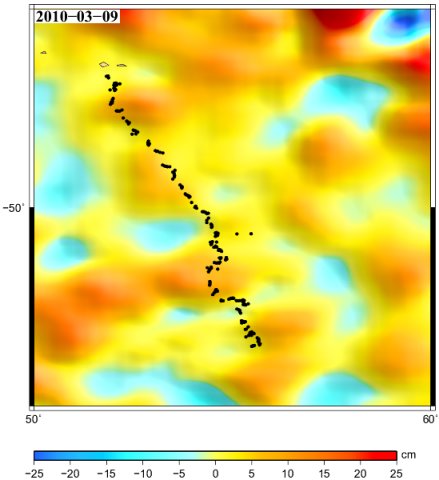Penguins and eddies
The Cnes educational project Argonautica aims to help better know the oceans, and understand the climate using satellites resources. Different beacons are thus tracked, and data are provided about the underlying ocean -- altimetry among others. Some of the satellite beacons are tracking animals, like King penguins (IPEV 394 programme, resp. C.A. Bost , CNRS Chizé).


Path of two King penguins from the Argonautica campaign 2009-2010 superimposed on sea surface height anomalies (in cm); They both started from the Possession island in the Crozet Archipelago. Left, the one named "King" by the students, right "Garfield". They are skirting the edges of eddies.
See the animation for King in gif (600 KB); and for Garfield in gif (1.7 MB). (Credits CNRS/CEBC)
The King penguins are living in the Southern Ocean. A number of them reproduce on the Crozet archipelago, the two parents taking turn to care for the egg, then for their young. They go from the islands to the open ocean, where they feed, before going back, and so on. During their foraging cruise, they tend to follow ocean currents, and to feed in oceanic fronts. The penguins paths are often seen at the edge of the eddies, between a cold and a warm one, especially in the areas where they slow down to feed. The edge of anticyclonic (warm-core) eddy presents an elevation of water masses, i.e. a more accessible concentration of prey at shallow depths
 King Penguin tracking from 2006-2007 (Sea level anomalies on January 1st 2007). In red, a penguin track from December 22 to January 13 during the incubation stage (using an anticyclonic eddy); in blue, another penguin, gone from January 12 to January 30 also during the incubation stage (but using a cyclonic eddy); and in pink, one gone from January 14 to 28, during young rearing (use of a cyclonic eddy) (Credits CNRS/CEBC)
King Penguin tracking from 2006-2007 (Sea level anomalies on January 1st 2007). In red, a penguin track from December 22 to January 13 during the incubation stage (using an anticyclonic eddy); in blue, another penguin, gone from January 12 to January 30 also during the incubation stage (but using a cyclonic eddy); and in pink, one gone from January 14 to 28, during young rearing (use of a cyclonic eddy) (Credits CNRS/CEBC)

